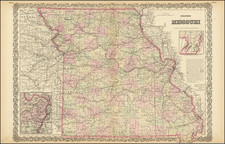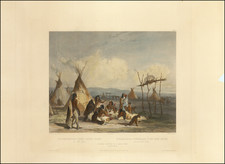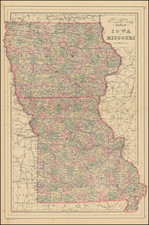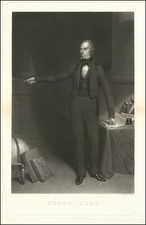Daguerreotype Portrait of a Distinguished Gentleman with Amblyopia
By a Pioneer St. Louis Photographer
A fine sixth plate daguerreotype, being a three-quarter portrait of a well-dressed, dignified gentleman. A small slip of paper (in an early manuscript hand) identifies the man as Samuel B. Smith. Clearly a distinguished fellow, Smith looks to be in his late 30s or early 40s. He sports neatly trimmed whiskers (sans moustache), and while he has one lazy eye, he exhibits a handsome countenance withal.
Prominent St. Louis Daguerreotypist
John H. Fitzgibbon may have learned how to make daguerreotypes in 1839 in Philadelphia, or perhaps a bit later, circa 1841, in Lynchburg, Virginia. At times he worked as an itinerant daguerreotypist, but is best known for his work in St. Louis, where he established a gallery in 1846. Fitzgibbon's St. Louis gallery was noted for its artistic portraiture. His grand "Daguerrean Gallery," located at No. 1 Fourth & Market Streets, comprised thirteen rooms, and was likely the largest photographic studio in the West. Fitzgibbon's trade card touted his patented "Crayon Daguerreotype Miniatures." In 1854 he toured Indian Territory and then in 1857 he traveled to Central and South America. In 1861 Fitzgibbon closed his St. Louis operation and moved to Vicksburg, Mississippi. The Civil War interrupted his photographic ventures and eventually he set up shop in New York. In 1869 Fitzgibbon returned to St. Louis. He also founded an early professional journal, St. Louis Practical Photographer.
In 1850 he advertised: "Those wishing their likenesses taken before leaving for California... to call at Fitzgibbon's Daguerreotype Gallery." Notably, Fitzgibbon was a collector of daguerreotypes himself, acquiring from Jeremiah Gurney the Robert H. Vance collection of three hundred whole-plate daguerreotypes of California and Central and South America, which he exhibited in his St. Louis gallery, which must have added to the prestige of his gallery/studio. And like other daguerreian empresarios Fitzgibbon got into the business of moving panorama pictures, commissioning and exhibiting the massive Panorama of Kansas and the Indian Nations, a painting apparently based on a series of his own daguerreotypes. According to Palmquist and Kailbourn, "the main feature of Fitzgibbon's panorama was a great scene of the Laying Down of Arms, by 2700 Border Ruffians, to Governor Geary, in which each main character allegedly was based on a daguerreotype." Alas, this monumental panorama is now lost.
The Metropolitan Museum has a daguerreotype by Fitzgibbon of Kno-Shr, a Kansa, styled one of the few dated pre-Civil War portraits of a Native American whose name and tribe are known.















![(Arizona Native American Photograph) [Original CDV of a Pima or Apache Child]](https://storage.googleapis.com/raremaps/img/small/93107.jpg)
![(North Dakota) Scalp Dance of the Minatarres [near Fort Clark, on the Missouri River]](https://storage.googleapis.com/raremaps/img/small/77692.jpg)